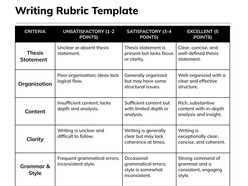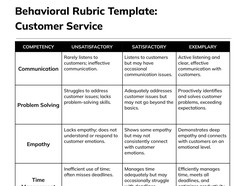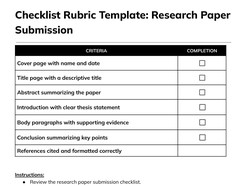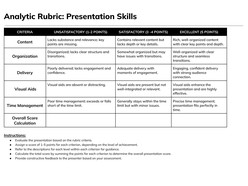A streamlined, adaptable holistic rubric template for Google Docs designed to evaluate student work based on overall performance rather than discrete components. Ideal for projects, writing assignments, presentations, and performance tasks where a single, overall judgment is most appropriate.
Content & Design Details:
Single-dimension scoring structure with clearly defined performance levels.
Performance descriptors span from high proficiency to minimal evidence of understanding.
Supports rapid, consistent evaluation of open-ended or subjective tasks.
Clean, printable layout optimized for paper-based or digital grading.
Includes labeled fields for task description, scoring levels, and optional teacher comments.
Fully editable for alignment with standards-based grading or narrative feedback systems.
Best suited for educators aiming to simplify grading without sacrificing clarity — especially in settings where a holistic impression better captures the quality of work than analytical breakdowns.
Format: Google Docs
How to Use
Accessing and editing the template in Google Docs takes only a few steps:
- Click the Download Template button to open the document in Google Docs.
- Select the Use Template button located in the top-right corner of the page.
- Ensure you are signed into your Google account to save and begin editing the file.
Once saved, the template becomes fully editable — ready for customization, printing, and sharing.
How to Use a Holistic Rubric in Google Docs to Simplify Evaluation While Preserving Fairness
Holistic rubrics provide a concise, overall judgment of student work, ideal when assessing projects, performances, or essays that require synthesis of multiple skills. Rather than scoring each component separately, holistic rubrics classify work into a single performance category. This method supports faster grading and emphasizes the overall quality of thinking and execution.
1. Understand When to Use Holistic Evaluation
Holistic rubrics are best used when the work being evaluated reflects an integrated performance — for example, creative writing, art critiques, or capstone projects. Use them when all criteria are interconnected or when speed and simplicity are priorities.
2. Define Clear Performance Categories
Use 3–5 performance levels such as “Advanced,” “Proficient,” “Developing,” and “Beginning.” Each level should describe the work’s overall effectiveness and completeness, not its parts.
3. Write Descriptors That Emphasize Whole-Task Quality
Instead of isolating criteria, write each level to reflect the overall quality. For example:
Proficient: “Effectively communicates ideas with minor lapses in clarity. Meets task requirements with appropriate depth and organization.”
Developing: “Partially meets task requirements; ideas are unclear or inconsistently developed.”
4. Use Google Docs to Draft and Share Easily
Tables in Google Docs structure the rubric neatly. Educators can edit level titles, tweak descriptions, or duplicate rubrics for multiple assignments. Collaborative editing enables departmental alignment.
5. Balance Efficiency With Feedback
Although holistic rubrics are fast to use, including a space for optional comments allows teachers to clarify the score and guide future improvement.
Why Google Docs Supports Holistic Rubric Use
Clean, editable layout for various subject areas
Seamless sharing for team-based or peer-reviewed assessment
Easy duplication for similar tasks
Print- and cloud-ready for hybrid teaching environments
Holistic rubrics emphasize the big picture — how well a student performs as a whole. With Google Docs, educators gain a simple, flexible tool to implement this approach efficiently and transparently.










